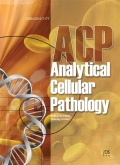Authors: Lind, Guro E. | Kleivi, Kristine | Meling, Gunn I. | Teixeira, Manuel R. | Thiis-Evensen, Espen | Rognum, Torleiv O. | Lothe, Ragnhild A.
Article Type:
Research Article
Abstract:
Background: Gene silencing through CpG island hypermethylation is a major mechanism in cancer development. In the present study, we aimed to identify and validate novel target genes inactivated through promoter hypermethylation in colorectal tumor development. Methods: With the use of microarrays, the gene expression profiles of colon cancer cell lines before and after treatment with the demethylating agent 5-aza-2′-deoxycytidine were identified and compared. The expression of the responding genes was compared with microarray expression data of primary colorectal carcinomas. Four of these down-regulated genes were subjected to methylation-specific PCR, bisulphite sequencing, and quantitative gene expression analysis using tumors (n=198), normal
…tissues (n=44), and cell lines (n=30). Results: Twenty-one genes with a CpG island in their promoter responded to treatment in cell lines, and were simultaneously down-regulated in primary colorectal carcinomas. Among 20 colon cancer cell lines, hypermethylation was subsequently identified for three of four analyzed genes, ADAMTS1 (85%), CRABP1 (90%), and NR3C1 (35%). For the latter two genes, hypermethylation was significantly associated with absence or reduced gene expression. The methylation status of ADAMTS1, CRABP1, and NR3C1 was further investigated in 116 colorectal carcinomas and adenomas. Twenty-three of 63 (37%), 7/60 (12%), and 2/63 (3%) adenomas, as well as 37/52 (71%), 25/51 (49%), and 13/51 (25%) carcinomas were hypermethylated for the respective genes. These genes were unmethylated in tumors (n=82) from three other organs, prostate, testis, and kidney. Finally, analysis of normal colorectal mucosa demonstrated that the observed promoter hypermethylation was cancer-specific. Conclusion: By using a refined microarray screening approach we present three genes with cancer-specific hypermethylation in colorectal tumors, ADAMTS1, CRABP1, and NR3C1.
Show more
Keywords: ADAMTS1, adenomas, bisulphite sequencing, colorectal carcinomas, CRABP1, gene expression, methylation, microarrays, NR3C1, 5-aza-2′deoxycytidine
Citation: Analytical Cellular Pathology,
vol. 28, no. 5-6, pp. 259-272, 2006
Price: EUR 27.50





